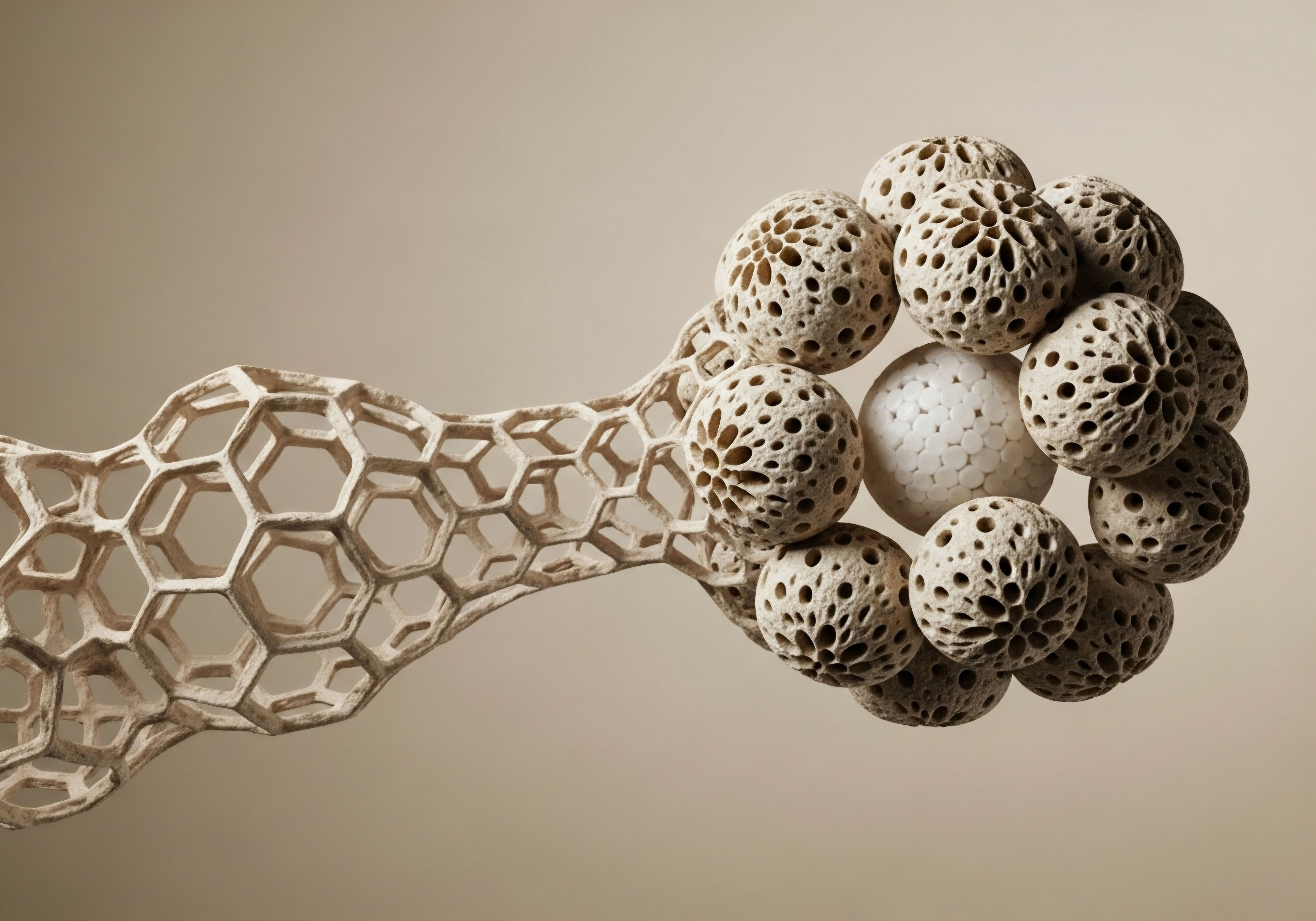

Fundamentals
Many individuals experience a subtle yet persistent shift in their well-being, a feeling that their internal rhythm has become slightly out of sync. Perhaps the energy that once flowed freely now feels elusive, or the clarity of thought has dimmed, replaced by a mental fog.
For some, it manifests as changes in body composition, sleep patterns, or even emotional resilience. These experiences are not merely isolated incidents; they often signal a deeper conversation happening within the body, specifically within the intricate world of its chemical messengers. Understanding these internal communications is the first step toward reclaiming vitality and function.
The body operates through a complex network of signaling molecules, with hormones serving as vital communicators. These chemical messengers, produced by various glands, travel through the bloodstream to target cells, orchestrating a vast array of physiological processes. From regulating metabolism and mood to influencing growth and reproduction, hormones maintain the delicate balance essential for optimal health. When this balance is disturbed, the downstream effects can ripple throughout every system, impacting daily life in profound ways.

The Endocrine System’s Orchestration
The endocrine system functions as the body’s central command center for hormonal regulation. It comprises glands such as the pituitary, thyroid, adrenal, and gonads, each contributing to a symphony of biochemical interactions. A particularly significant regulatory pathway is the Hypothalamic-Pituitary-Gonadal (HPG) axis.
This axis acts as a sophisticated feedback loop, ensuring appropriate hormone production and release. The hypothalamus, located in the brain, sends signals to the pituitary gland, which then directs the gonads (testes in men, ovaries in women) to produce their respective sex hormones. This intricate communication system ensures that hormone levels remain within a healthy range, adapting to the body’s needs.
Hormones act as the body’s internal messaging service, coordinating essential physiological processes to maintain overall well-being.
Disruptions within this axis, whether due to aging, environmental factors, or lifestyle choices, can lead to a cascade of symptoms. Recognizing these signals is paramount for anyone seeking to understand their own biological systems. The experience of feeling “off” is a valid indicator that the body’s internal communication lines may require attention.

Distinct Biological Architectures
While the fundamental principles of hormonal regulation apply universally, the specific architecture and primary functions of the endocrine system differ significantly between biological men and women. These differences dictate distinct approaches to hormonal optimization. For men, the primary sex hormone is testosterone, produced predominantly by the testes.
This hormone is responsible for male secondary sexual characteristics, muscle mass, bone density, red blood cell production, and libido. Its decline, often associated with aging, can lead to a constellation of symptoms commonly referred to as andropause.
Women, conversely, experience a more cyclical and complex hormonal landscape, primarily governed by estrogen and progesterone, produced by the ovaries. These hormones regulate the menstrual cycle, reproductive health, bone density, and cardiovascular function. As women approach and navigate menopause, the decline in ovarian hormone production leads to significant physiological changes, impacting various bodily systems. Understanding these inherent biological distinctions forms the bedrock of personalized hormonal support.

Initial Considerations for Hormonal Balance
Approaching hormonal balance requires an individualized perspective. It begins with a thorough assessment of symptoms, a detailed medical history, and comprehensive laboratory testing. These initial steps help to paint a clear picture of an individual’s unique hormonal status.
For instance, a man experiencing fatigue and reduced libido might have his testosterone levels evaluated, while a woman with irregular cycles and hot flashes would likely have her estrogen and progesterone levels assessed. The goal is always to identify specific imbalances and their underlying causes, rather than simply addressing symptoms in isolation.
The journey toward hormonal vitality is a collaborative one, where clinical insights meet personal experience. It involves translating complex biochemical data into practical strategies that support the body’s innate capacity for balance and resilience. This foundational understanding sets the stage for exploring the more specific protocols and interventions available for men and women seeking to reclaim their optimal health.


Intermediate
The path to restoring hormonal equilibrium requires a precise and evidence-based approach, tailored to the unique physiological landscape of each individual. Hormonal optimization protocols are not one-size-fits-all solutions; they are carefully calibrated interventions designed to recalibrate the body’s intricate internal communication systems. The specific agents and dosages employed vary significantly based on biological sex, presenting distinct considerations for men and women.

Testosterone Replacement Therapy for Men
For men experiencing symptoms associated with declining testosterone levels, often termed hypogonadism or andropause, Testosterone Replacement Therapy (TRT) offers a targeted solution. The objective of TRT is to restore testosterone to physiological levels, thereby alleviating symptoms such as reduced energy, decreased muscle mass, diminished libido, and mood disturbances.
A common and effective protocol involves weekly intramuscular injections of Testosterone Cypionate, typically at a concentration of 200mg/ml. This method provides a steady release of the hormone, mimicking the body’s natural production patterns.
However, simply administering testosterone can have downstream effects, particularly on the body’s natural production mechanisms and the conversion of testosterone to estrogen. To mitigate these potential issues, a comprehensive TRT protocol often includes additional medications.
- Gonadorelin ∞ Administered via subcutaneous injections, typically twice weekly, Gonadorelin helps maintain the body’s natural testosterone production and preserves testicular function, which is crucial for fertility. It acts by stimulating the release of Luteinizing Hormone (LH) and Follicle-Stimulating Hormone (FSH) from the pituitary gland.
- Anastrozole ∞ This oral tablet, taken twice weekly, functions as an aromatase inhibitor. Its purpose is to block the conversion of testosterone into estrogen, thereby reducing potential side effects such as gynecomastia (breast tissue development) or water retention, which can occur when estrogen levels become elevated.
- Enclomiphene ∞ In some cases, Enclomiphene may be incorporated into the protocol. This medication selectively blocks estrogen receptors in the pituitary, leading to increased release of LH and FSH, which in turn stimulates the testes to produce more testosterone. It can be particularly useful for men seeking to maintain fertility while optimizing testosterone levels.
Male hormonal optimization protocols often combine testosterone administration with agents that preserve natural production and manage estrogen conversion.

Testosterone Replacement Therapy for Women
Hormonal balance for women, particularly during peri-menopause and post-menopause, also benefits from precise interventions. While estrogen and progesterone are primary considerations, low testosterone in women can contribute to symptoms like reduced libido, fatigue, and diminished well-being. The approach to testosterone optimization in women is distinct, utilizing much lower dosages to align with their physiological needs.
A typical protocol for women involves weekly subcutaneous injections of Testosterone Cypionate, usually in very small doses, ranging from 10 to 20 units (0.1 ∞ 0.2ml). This micro-dosing strategy aims to restore testosterone to optimal physiological ranges without inducing masculinizing side effects. The precise dosage is determined by individual symptoms and laboratory values, ensuring a tailored approach.
Progesterone is another cornerstone of female hormonal balance, prescribed based on menopausal status and individual needs. It plays a vital role in regulating the menstrual cycle, supporting bone health, and influencing mood. For some women, Pellet Therapy offers a long-acting testosterone delivery method, where small pellets are inserted under the skin, providing a consistent release of the hormone over several months.
When appropriate, Anastrozole may also be used in women, albeit at even lower doses than in men, to manage estrogen levels if necessary, particularly in the context of pellet therapy.

Post-TRT or Fertility-Stimulating Protocol for Men
For men who have discontinued TRT or are actively trying to conceive, a specific protocol is implemented to reactivate natural testosterone production and support fertility. This protocol aims to stimulate the HPG axis, which may have become suppressed during exogenous testosterone administration.
The protocol typically includes a combination of agents designed to restore endogenous hormone production:
- Gonadorelin ∞ Continues to be a key component, stimulating the pituitary to release LH and FSH, thereby signaling the testes to resume testosterone production.
- Tamoxifen ∞ This medication, a selective estrogen receptor modulator (SERM), blocks estrogen’s negative feedback on the hypothalamus and pituitary, leading to increased GnRH, LH, and FSH release. This action directly stimulates testicular function.
- Clomid (Clomiphene Citrate) ∞ Similar to Tamoxifen, Clomid is another SERM that enhances the release of gonadotropins, promoting natural testosterone synthesis and spermatogenesis.
- Anastrozole (Optional) ∞ May be included if estrogen levels remain elevated, to prevent excessive estrogenic feedback that could hinder the recovery of the HPG axis.

Growth Hormone Peptide Therapy
Beyond sex hormones, specific peptides can play a significant role in optimizing overall well-being, particularly for active adults and athletes seeking benefits related to anti-aging, body composition, and recovery. These peptides work by stimulating the body’s natural production of growth hormone (GH), avoiding the direct administration of synthetic GH.
The mechanisms involve stimulating the pituitary gland to release more of its own growth hormone. This approach leverages the body’s inherent regulatory systems, often leading to more physiological responses.
| Peptide Name | Primary Mechanism of Action | Common Applications |
|---|---|---|
| Sermorelin | Growth Hormone-Releasing Hormone (GHRH) analog, stimulates pituitary GH release. | Anti-aging, improved sleep quality, enhanced recovery. |
| Ipamorelin / CJC-1295 | Ipamorelin is a GH secretagogue; CJC-1295 is a GHRH analog. Often combined for synergistic effect. | Muscle gain, fat loss, improved sleep, collagen synthesis. |
| Tesamorelin | GHRH analog, specifically reduces visceral adipose tissue. | Targeted fat loss, particularly abdominal fat. |
| Hexarelin | GH secretagogue, potent stimulator of GH release. | Muscle growth, fat reduction, enhanced healing. |
| MK-677 (Ibutamoren) | Oral GH secretagogue, mimics ghrelin’s action. | Increased GH and IGF-1 levels, improved sleep, appetite stimulation. |

Other Targeted Peptides
The therapeutic landscape of peptides extends beyond growth hormone regulation, offering targeted solutions for specific physiological needs.
- PT-141 (Bremelanotide) ∞ This peptide is specifically utilized for sexual health. It acts on melanocortin receptors in the brain, influencing pathways related to sexual arousal and desire. It is effective for both men and women experiencing sexual dysfunction, offering a non-hormonal approach to enhancing libido and sexual response.
- Pentadeca Arginate (PDA) ∞ PDA is gaining recognition for its role in tissue repair, healing processes, and inflammation modulation. Its mechanisms involve supporting cellular regeneration and reducing inflammatory responses, making it a valuable tool in recovery protocols and for addressing chronic inflammatory conditions.
These detailed protocols highlight the precision required in hormonal optimization. Each agent serves a specific purpose within the broader goal of restoring systemic balance, allowing individuals to experience a profound return to vitality and function. The choice of protocol is always a collaborative decision, guided by clinical expertise and the individual’s unique biological blueprint.


Academic
A deep understanding of hormonal optimization necessitates an exploration of the intricate biochemical and physiological pathways that govern endocrine function. Moving beyond symptomatic relief, a systems-biology perspective reveals how various hormonal axes intercommunicate, influencing metabolic health, cognitive function, and overall cellular resilience. The distinction in optimization strategies for men and women becomes even more pronounced when considering these underlying molecular mechanisms and their systemic repercussions.

The Hypothalamic-Pituitary-Gonadal Axis ∞ A Deeper Dive
The HPG axis represents a sophisticated neuroendocrine feedback loop, central to reproductive and metabolic health in both sexes, yet with distinct operational nuances. In men, the hypothalamus releases Gonadotropin-Releasing Hormone (GnRH) in a pulsatile manner, stimulating the anterior pituitary to secrete Luteinizing Hormone (LH) and Follicle-Stimulating Hormone (FSH).
LH primarily acts on the Leydig cells in the testes to produce testosterone, while FSH targets the Sertoli cells, supporting spermatogenesis. Testosterone, in turn, exerts negative feedback on both the hypothalamus and pituitary, regulating its own production. This precise feedback mechanism ensures homeostatic control of male androgen levels.
For women, the HPG axis exhibits a more complex, cyclical pattern. GnRH pulses from the hypothalamus drive LH and FSH release from the pituitary, which then act on the ovaries. FSH stimulates follicular growth and estrogen production, while LH triggers ovulation and subsequent progesterone production from the corpus luteum.
Estrogen and progesterone provide feedback to the hypothalamus and pituitary, with estrogen exhibiting both negative and positive feedback depending on its concentration and the phase of the menstrual cycle. This cyclical interplay is fundamental to female reproductive physiology and explains the dynamic hormonal shifts experienced throughout a woman’s life.
The HPG axis, a central neuroendocrine feedback loop, operates with distinct pulsatile and cyclical patterns in men and women, respectively.

Androgen Receptor Sensitivity and Metabolism
The efficacy of testosterone optimization protocols is not solely dependent on circulating hormone levels but also on androgen receptor (AR) sensitivity and the metabolic fate of testosterone. In men, testosterone exerts its effects by binding to ARs in target tissues, or by being converted to dihydrotestosterone (DHT) via the 5-alpha-reductase enzyme, which has a higher affinity for ARs.
Testosterone can also be aromatized into estrogen by the aromatase enzyme, particularly in adipose tissue. Elevated estrogen levels in men can lead to adverse effects, necessitating the use of aromatase inhibitors like Anastrozole to maintain a healthy testosterone-to-estrogen ratio.
In women, while testosterone levels are significantly lower, its role is equally vital. Women possess ARs in various tissues, including bone, brain, and muscle, where testosterone contributes to bone density, cognitive function, and muscle mass. The conversion of testosterone to DHT and estrogen also occurs in women, and imbalances in these metabolic pathways can contribute to symptoms.
For instance, excessive DHT conversion can lead to androgenic side effects like acne or hirsutism, while disproportionate aromatization can impact estrogen balance. This intricate metabolic interplay underscores the need for precise, low-dose testosterone administration in women to avoid supraphysiological levels and their associated consequences.

Growth Hormone Secretagogues and Somatotropic Axis
The application of growth hormone-releasing peptides, or GH secretagogues, represents a sophisticated approach to modulating the somatotropic axis. This axis involves the hypothalamus, pituitary, and liver, regulating growth hormone (GH) and Insulin-like Growth Factor 1 (IGF-1). The hypothalamus releases GHRH, stimulating pituitary GH secretion. GH then acts on target tissues, particularly the liver, to produce IGF-1, which mediates many of GH’s anabolic and metabolic effects.
Peptides like Sermorelin and CJC-1295 are synthetic GHRH analogs, directly stimulating the pituitary’s somatotrophs to release endogenous GH. Ipamorelin and Hexarelin, on the other hand, are GH secretagogues that mimic the action of ghrelin, binding to the ghrelin receptor (GHS-R) on pituitary cells, leading to a pulsatile release of GH.
This approach differs fundamentally from exogenous GH administration, as it respects the body’s natural feedback mechanisms, promoting a more physiological release pattern and reducing the risk of desensitization or negative feedback suppression.
The benefits observed with these peptides ∞ improved body composition, enhanced recovery, and better sleep ∞ are mediated by their downstream effects on cellular metabolism and protein synthesis. For example, increased GH and IGF-1 levels can promote lipolysis (fat breakdown) and protein anabolism (muscle building), while also influencing glucose metabolism and insulin sensitivity.
The precise selection of a peptide or combination of peptides depends on the specific clinical objective, whether it is targeted fat reduction (Tesamorelin), general anti-aging (Sermorelin), or enhanced muscle anabolism (Ipamorelin/CJC-1295).

Neuroendocrine Interconnections and Peptide Actions
The endocrine system does not operate in isolation; it is deeply interconnected with the nervous system and metabolic pathways. This intricate web of communication is particularly evident in the actions of certain peptides. For instance, PT-141 (Bremelanotide), a synthetic melanocortin receptor agonist, acts centrally within the brain.
It binds to melanocortin receptors, particularly MC3R and MC4R, which are involved in regulating sexual function, appetite, and energy homeostasis. Its mechanism of action for sexual health bypasses the traditional hormonal pathways, directly influencing neurochemical signals that govern arousal and desire. This highlights a sophisticated understanding of how peptides can modulate complex physiological responses through specific receptor interactions within the central nervous system.
Similarly, the emerging understanding of peptides like Pentadeca Arginate (PDA) points to their roles in tissue repair and inflammation. While specific molecular targets are still under active investigation, such peptides are thought to interact with cellular signaling pathways involved in wound healing, extracellular matrix remodeling, and immune modulation. Their ability to support cellular regeneration and mitigate inflammatory cascades positions them as valuable tools in restorative and anti-inflammatory protocols, offering a glimpse into the future of targeted biochemical support.
The academic pursuit of hormonal optimization reveals a landscape of remarkable complexity and precision. Each intervention, whether it involves sex hormones or peptides, is a deliberate attempt to recalibrate a highly sensitive biological system. The goal is always to restore the body’s inherent capacity for balance, allowing individuals to experience a profound and sustained return to their optimal state of vitality.

How Do Hormonal Influences Affect Metabolic Pathways?
Hormones are master regulators of metabolism, influencing how the body processes energy, stores fat, and utilizes glucose. The interplay between sex hormones, thyroid hormones, and insulin is particularly significant. For men, declining testosterone levels can contribute to insulin resistance, increased visceral adiposity, and a less favorable lipid profile.
Testosterone plays a role in glucose uptake by muscle cells and influences adipocyte differentiation. Therefore, optimizing testosterone in men can have beneficial effects on metabolic markers, potentially reducing the risk of metabolic syndrome.
In women, the cyclical fluctuations and eventual decline of estrogen and progesterone during peri-menopause and menopause have profound metabolic consequences. Estrogen influences insulin sensitivity, fat distribution, and cardiovascular health. As estrogen levels decrease, women often experience a shift in fat storage towards the abdomen, an increase in insulin resistance, and changes in cholesterol profiles.
Progesterone also plays a role in metabolic regulation, influencing glucose metabolism and appetite. Hormonal optimization in women, therefore, extends beyond symptom management to address these metabolic shifts, aiming to restore a healthier metabolic phenotype.
| Hormone | Primary Metabolic Impact in Men | Primary Metabolic Impact in Women |
|---|---|---|
| Testosterone | Improves insulin sensitivity, reduces visceral fat, supports lean muscle mass. | Contributes to lean muscle mass, bone density, and metabolic rate (at physiological levels). |
| Estrogen | Elevated levels can increase fat storage, reduce insulin sensitivity. | Maintains insulin sensitivity, favorable fat distribution, cardiovascular protection. Decline leads to metabolic shifts. |
| Progesterone | Minimal direct role in male metabolism. | Influences glucose metabolism, appetite, and mood; supports healthy metabolic function. |
| Growth Hormone / IGF-1 | Promotes lipolysis, protein synthesis, glucose utilization in muscle. | Similar effects, crucial for tissue repair, fat metabolism, and overall cellular regeneration. |

Can Hormonal Balance Influence Cognitive Function?
The brain is a highly hormonally sensitive organ, and fluctuations in endocrine balance can significantly impact cognitive function, mood, and neurological health. Sex hormones, in particular, exert widespread effects on neurotransmitter systems, neuronal plasticity, and cerebral blood flow. In men, adequate testosterone levels are associated with better spatial cognition, verbal memory, and overall mood stability.
Low testosterone can contribute to symptoms of brain fog, reduced mental acuity, and even depressive symptoms. Testosterone’s influence on dopamine and serotonin pathways is a key area of research, highlighting its role in motivation and emotional regulation.
For women, estrogen plays a critical neuroprotective role, influencing memory, mood, and synaptic function. The decline in estrogen during peri-menopause and menopause is often accompanied by cognitive complaints, including memory lapses and difficulties with concentration. Progesterone also influences brain function, with its metabolites having neurosteroid properties that can affect mood and sleep architecture.
Hormonal optimization in women, therefore, often aims to support cognitive vitality and emotional resilience by restoring physiological levels of these neuroactive hormones. The precise mechanisms involve modulation of neurotransmitter synthesis and receptor expression, as well as influencing neuroinflammation and mitochondrial function within brain cells.

References
- Jones, R. E. & Lopez, K. H. (2014). Human Reproductive Biology (4th ed.). Academic Press.
- Speroff, L. & Fritz, M. A. (2019). Clinical Gynecologic Endocrinology and Infertility (9th ed.). Wolters Kluwer.
- Bhasin, S. & Jasuja, R. (2017). Testosterone and Selective Androgen Receptor Modulators (SARMs) as Anabolic Agents in Clinical Practice. Endocrine Reviews, 38(4), 305 ∞ 321.
- Katznelson, L. et al. (2011). Growth Hormone Deficiency in Adults ∞ An Endocrine Society Clinical Practice Guideline. The Journal of Clinical Endocrinology & Metabolism, 96(3), 693 ∞ 703.
- Davis, S. R. et al. (2015). Global Consensus Position Statement on the Use of Testosterone Therapy for Women. The Journal of Clinical Endocrinology & Metabolism, 100(12), 4633 ∞ 4642.
- Handelsman, D. J. (2013). Androgen Physiology, Pharmacology and Abuse. Oxford University Press.
- Miller, K. K. et al. (2010). Effects of Growth Hormone on Body Composition and Metabolic Parameters in Adults with Growth Hormone Deficiency. The Journal of Clinical Endocrinology & Metabolism, 95(1), 12 ∞ 21.
- Traish, A. M. et al. (2011). The Dark Side of Testosterone Deficiency ∞ I. Metabolic and Cardiovascular Consequences. Journal of Andrology, 32(5), 477 ∞ 494.
- Genazzani, A. R. et al. (2007). Neuroendocrine and Metabolic Effects of Growth Hormone-Releasing Peptides. Annals of the New York Academy of Sciences, 1119, 119 ∞ 129.
- Gottfried, S. (2013). The Hormone Cure ∞ Reclaim Your Body, Balance Your Hormones, Stop Weight Gain, Feel Great, and Look Young Again. Scribner.

Reflection
Having explored the intricate distinctions and shared principles of hormonal optimization for men and women, you now possess a deeper understanding of the body’s remarkable internal systems. This knowledge is not merely academic; it is a powerful lens through which to view your own experiences and sensations. Consider how the insights into the HPG axis, specific hormonal protocols, and the broader metabolic and cognitive interconnections might resonate with your personal health journey.
The symptoms you may have felt ∞ the shifts in energy, mood, or physical resilience ∞ are not random occurrences. They are often precise signals from a system seeking balance. This understanding empowers you to move beyond simply accepting these changes, instead recognizing them as invitations to engage more deeply with your own biology. The path to reclaiming vitality is a personal expedition, unique to your individual physiology and lived experience.
This exploration serves as a foundational step, providing the scientific context for informed decisions. True optimization, however, requires personalized guidance, where clinical expertise meets your unique biological blueprint. The journey toward a more vibrant and functional self is not a destination, but a continuous process of understanding, recalibration, and proactive engagement with your body’s innate intelligence.



